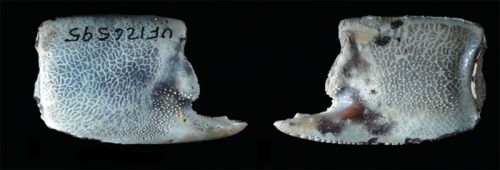
This Fossil Friday, I’m excited to share a fossil shrimp that was just described in a publication by FLMNH Postdoc Adiël Klompmaker and colleagues! Fossils of this new ghost shrimp, called Glypturus panamacanalensis, were found by M. D. Burkenroad in 1959, who collected from Holo-Pleistocene dredgings on the Amador and Farfan beaches at the entrance of the Panama Canal. Specimens of this shrimp have also been found in Florida and Cuba, and modern members of the genus Glypturus live in the salty waters of the Western Atlantic, the Indian Ocean, the southwest Pacific, and the Red Sea.

Shrimp, along with crabs and lobsters, are decapods (Phylum Arthropoda, Class Malacostraca, Order Decapoda). Decapods commonly have differently sized claws, referred to as major propodi and minor propodi. The larger major propodus is used for crushing while the smaller, sharper minor propodus is used for cutting.
Be sure to check out the paper on this new species of mud shrimp here!
Reference: